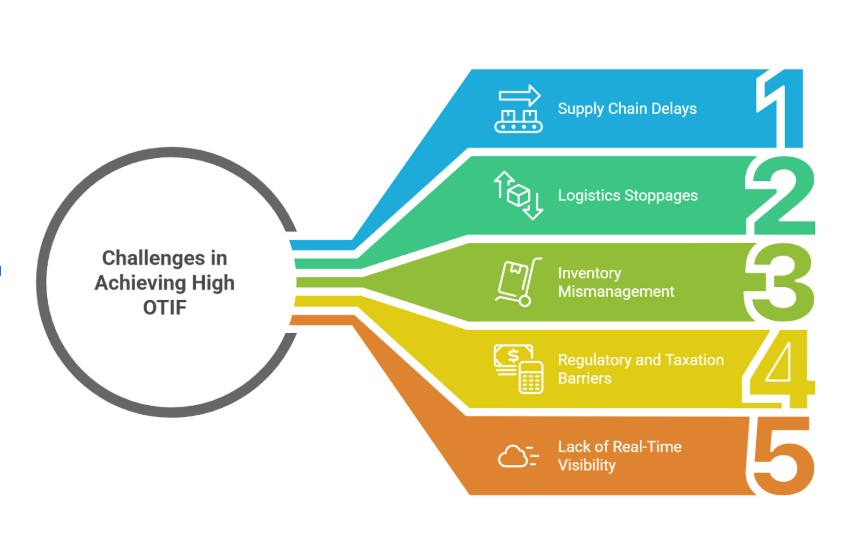Discover how to move from reactive to reliable: actionable ways to improve OTIF (On-Time, In-Full) delivery via better planning, routing intelligence and seamless collaboration.
OTIF Isn’t a Metric—It’s Your Promise
In logistics, we call our promise to the customer ‘on-time and in-full’ (OTIF); however, many teams still think of OTIF as something that happens after the fact. MetricHQ reports that industry benchmarks for OTIF sit around 92-99% depending on the sector, but those performance numbers translate into four-figure penalties, lost contracts and hidden costs when we fail to fulfill our promise. For brokers, carriers, and shippers, OTIF performance can be enhanced by embedding OTIF into planning, routing and communication, rather than our traditional response to failure.
Why OTIF Breaks Down: The Real Causes
There are no surprises when you dig into the data. Here’s where performance typically falters:
Planning Without Predictive Insight
A survey of food & beverage shippers found 59% track KPIs daily, yet 44% struggle to use KPI results to change tactics. That gap means loads are still being scheduled based on last year’s average instead of live risk models, and OTIF suffers.
Routing for Distance Instead of Reliability
In actual freight operations, the shortest distance is not always the fastest. A case study associated with Kelley’s work in 2020 indicates that a 42% increase in on-time, in-full (OTIF) performance occurred after changing routing decisions from distance-based decisions to reliability and delay history based decisions.
Siloed Communication Between Parties
When carriers, brokers and shippers operate in isolated systems, delay signals get lost. One firm improved OTIF from 72% to 89% within a year by giving all partners access to one shared dashboard with real-time alerts.
Read more: What Is Predictive Analytics in Logistics: Turning Load History into Actionable Insights
Why OTIF Breaks Down: The Real Causes
There are no surprises when you dig into the data. Here’s where performance typically falters:
Planning Without Predictive Insight
A survey of food & beverage shippers found 59% track KPIs daily, yet 44% struggle to use KPI results to change tactics. That gap means loads are still being scheduled based on last year’s average instead of live risk models, and OTIF suffers.
Routing for Distance Instead of Reliability
In actual freight operations, the shortest distance is not always the fastest. A case study associated with Kelley’s work in 2020 indicates that a 42% increase in on-time, in-full (OTIF) performance occurred after changing routing decisions from distance-based decisions to reliability and delay history based decisions.
Siloed Communication Between Parties
When carriers, brokers and shippers operate in isolated systems, delay signals get lost. One firm improved OTIF from 72% to 89% within a year by giving all partners access to one shared dashboard with real-time alerts.
Read more: What Is Predictive Analytics in Logistics: Turning Load History into Actionable Insights
Three Pillars to Improve OTIF Performance
Let’s explore strategic areas that deliver measurable improvement in OTIF performance.
1. Plan Forward: Data-Powered Forecasting
Rather than reactive mode when a load is already late – move to a risk forecasting model. Top performers look at OTIF loss by node (supplier, carrier, terminal), and create mitigation playbooks for each. McKinsey says companies with successful operations use logistics control towers and reporting to drive OTIF. If you manage your planning towards risk zones, volume changes, and lane-level variability, you can allocate and reduce exposure before the clock starts..
2. Route for Reliability, Not Just Shortest Miles
An effective dispatch engine must do more than just find the shortest route, it should assess historical bottlenecks, traffic data, carrier reliability, and time window restraints. For example, routing decisions that account for dwell time and traffic slowdowns produce more OTIF shipments than purely mileage-based algorithms. Focusing on reliability, rather than lead-time, creates a competitive service objective.
Read more: Struggling with OTIF? How to Hit On-Time, In-Full Deliveries Every Time
3. Collaborate in Real Time Across the Network
Amidst the number of players in the chain—suppliers, carriers, hubs, and brokers—visibility is essential. Having real-time dashboards and alerting everyone in the chain when an exception occurs (for example, dwell time, weather delay, or missing POD) will hasten the speed of response. Weekly joint review meetings between the procurement, operations and carriers enhances accountability and helps eliminate repeat misses with carriers. Case studies have shown that visibility alongside cross-functional reviews resulted in a 96% or above OTIF.

Actionable Steps: OTIF Improvement Table
| Action Step | Why It Improves OTIF |
| Break down OTIF by lane, carrier and customer | Enables focused interventions rather than blanket fixes |
| Use predictive delay scoring in planning | Shifts from reactive to proactive management |
| Route using reliability scores + real-time data | Reduces variability and improves delivery consistency |
| Implement shared alerts across partners | Speeds response when deviations occur |
| Hold weekly OTIF review sessions | Keeps teams aligned and identifies persistent issues |
Practical Scenario: One Lane, One Week
Let’s say you have a recurring lane between DC-X and Retailer-Y suffering 88% OTIF. Instead of simply blaming carriers, you:
- Review historical data and find the route consistently departs late on Monday mornings.
- Use predictive scoring to flag that Monday loads into this lane face higher risk of detention and traffic.
- Re-schedule that lane for Tuesday morning, adjust carrier assignment to a higher-performing provider, and route using an alternate corridor with lower historical dwell.
- Set an alert: if loading isn’t done by 10 am, trigger backup plan.
Result: you increase that lane’s OTIF to 95% within a month.
This example shows how planning, routing and collaboration align to improve OTIF performance, not just chasing higher numbers.
Read more: End-to-End Supply Chain Visibility: Eliminating Blind Spots in Logistics
OTIF as Competitive Advantage
Elevating OTIF results isn’t just achieving a KPI, it’s changing delivery into a competitive promise. Shippers and brokers that focus on forecasting, route-reliability and communication across networks will not only meet SLAs, they will build loyalty and market share. Logistics’ future isn’t just about being on time, it’s about being consistently reliable.
- Ready to elevate your OTIF performance and operational consistency?
Book your free demo and begin your transformation now.


Love the emphasis on collaboration across carriers, brokers, and shippers. Real-time shared dashboards make a big difference.
I really like the framing of OTIF (On‑Time, In‑Full) as not just a KPI after the fact but as a promise to the customer. That mindset shift (from reactive to proactive) changes everything.